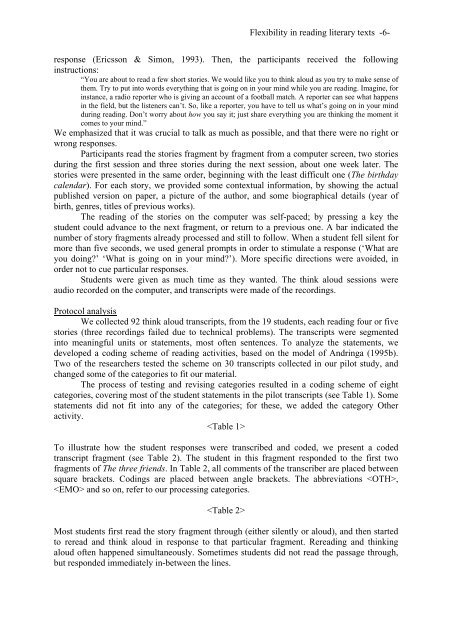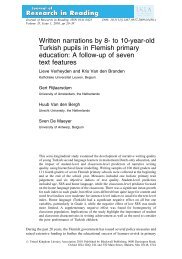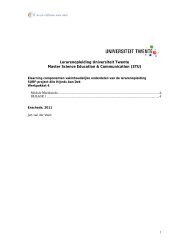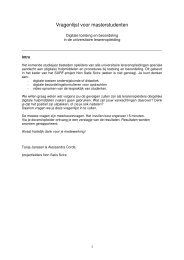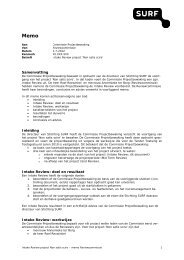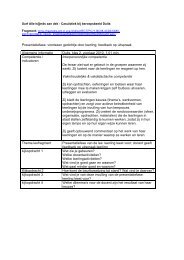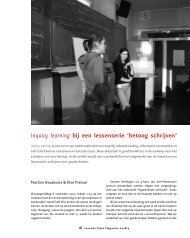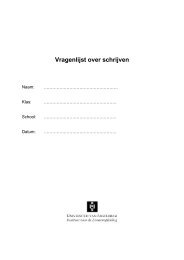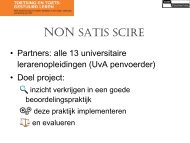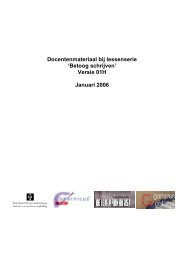Adaptivity in reading literary texts;
Adaptivity in reading literary texts;
Adaptivity in reading literary texts;
You also want an ePaper? Increase the reach of your titles
YUMPU automatically turns print PDFs into web optimized ePapers that Google loves.
Flexibility <strong>in</strong> read<strong>in</strong>g <strong>literary</strong> <strong>texts</strong> -6-<br />
response (Ericsson & Simon, 1993). Then, the participants received the follow<strong>in</strong>g<br />
<strong>in</strong>structions:<br />
“You are about to read a few short stories. We would like you to th<strong>in</strong>k aloud as you try to make sense of<br />
them. Try to put <strong>in</strong>to words everyth<strong>in</strong>g that is go<strong>in</strong>g on <strong>in</strong> your m<strong>in</strong>d while you are read<strong>in</strong>g. Imag<strong>in</strong>e, for<br />
<strong>in</strong>stance, a radio reporter who is giv<strong>in</strong>g an account of a football match. A reporter can see what happens<br />
<strong>in</strong> the field, but the listeners can’t. So, like a reporter, you have to tell us what’s go<strong>in</strong>g on <strong>in</strong> your m<strong>in</strong>d<br />
dur<strong>in</strong>g read<strong>in</strong>g. Don’t worry about how you say it; just share everyth<strong>in</strong>g you are th<strong>in</strong>k<strong>in</strong>g the moment it<br />
comes to your m<strong>in</strong>d.”<br />
We emphasized that it was crucial to talk as much as possible, and that there were no right or<br />
wrong responses.<br />
Participants read the stories fragment by fragment from a computer screen, two stories<br />
dur<strong>in</strong>g the first session and three stories dur<strong>in</strong>g the next session, about one week later. The<br />
stories were presented <strong>in</strong> the same order, beg<strong>in</strong>n<strong>in</strong>g with the least difficult one (The birthday<br />
calendar). For each story, we provided some contextual <strong>in</strong>formation, by show<strong>in</strong>g the actual<br />
published version on paper, a picture of the author, and some biographical details (year of<br />
birth, genres, titles of previous works).<br />
The read<strong>in</strong>g of the stories on the computer was self-paced; by press<strong>in</strong>g a key the<br />
student could advance to the next fragment, or return to a previous one. A bar <strong>in</strong>dicated the<br />
number of story fragments already processed and still to follow. When a student fell silent for<br />
more than five seconds, we used general prompts <strong>in</strong> order to stimulate a response (‘What are<br />
you do<strong>in</strong>g?’ ‘What is go<strong>in</strong>g on <strong>in</strong> your m<strong>in</strong>d?’). More specific directions were avoided, <strong>in</strong><br />
order not to cue particular responses.<br />
Students were given as much time as they wanted. The th<strong>in</strong>k aloud sessions were<br />
audio recorded on the computer, and transcripts were made of the record<strong>in</strong>gs.<br />
Protocol analysis<br />
We collected 92 th<strong>in</strong>k aloud transcripts, from the 19 students, each read<strong>in</strong>g four or five<br />
stories (three record<strong>in</strong>gs failed due to technical problems). The transcripts were segmented<br />
<strong>in</strong>to mean<strong>in</strong>gful units or statements, most often sentences. To analyze the statements, we<br />
developed a cod<strong>in</strong>g scheme of read<strong>in</strong>g activities, based on the model of Andr<strong>in</strong>ga (1995b).<br />
Two of the researchers tested the scheme on 30 transcripts collected <strong>in</strong> our pilot study, and<br />
changed some of the categories to fit our material.<br />
The process of test<strong>in</strong>g and revis<strong>in</strong>g categories resulted <strong>in</strong> a cod<strong>in</strong>g scheme of eight<br />
categories, cover<strong>in</strong>g most of the student statements <strong>in</strong> the pilot transcripts (see Table 1). Some<br />
statements did not fit <strong>in</strong>to any of the categories; for these, we added the category Other<br />
activity.<br />
<br />
To illustrate how the student responses were transcribed and coded, we present a coded<br />
transcript fragment (see Table 2). The student <strong>in</strong> this fragment responded to the first two<br />
fragments of The three friends. In Table 2, all comments of the transcriber are placed between<br />
square brackets. Cod<strong>in</strong>gs are placed between angle brackets. The abbreviations ,<br />
and so on, refer to our process<strong>in</strong>g categories.<br />
<br />
Most students first read the story fragment through (either silently or aloud), and then started<br />
to reread and th<strong>in</strong>k aloud <strong>in</strong> response to that particular fragment. Reread<strong>in</strong>g and th<strong>in</strong>k<strong>in</strong>g<br />
aloud often happened simultaneously. Sometimes students did not read the passage through,<br />
but responded immediately <strong>in</strong>-between the l<strong>in</strong>es.


